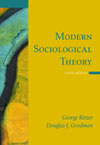
Symbolic Interactionism |  |
Chapter Outline
I. The Major Historical RootsA. Pragmatism B. Behaviorism C. Between Reductionism and Sociologism |
II. The Ideas of George Herbert MeadA. Biographical Sketch B. Priority of the Social 1. The Act
2. Impulse
3. Perception
4. Manipulation
5. Consummation
C. Gestures D. Significant Symbols E. Mind F. Self 1. Child Development
a. play stage
b. game stage
2. Generalized Other
3. "I" and "Me"
G. Society |
III. Symbolic Interactionism: The Basic PrinciplesA. Capacity for Thought B. Thinking and Interaction C. Learning Meanings and Symbols D. Action and Interaction E. Making Choices F. The Self and the Work of Erving Goffman 1. Biographical Sketch
2. Dramaturgy
a. front
b. setting
c. personal front
d. appearance
e. manner
f. mystification
g. teams
h. back stage
i. outside
3. Impression Management
4. Role Distance
5. Stigma
6. Frame Analysis
G. Groups and Societies |
V. Toward a More Synthetic and Integrative Symbolic InteractionismA. Redefining the Mind B. Micro-Macro Integration 1. Figure: An Overview of the Components of Mead's Theoretical System
C. Symbolic Interactionism and Cultural Studies |
VI. The Future of Symbolic Interactionism |
|
|